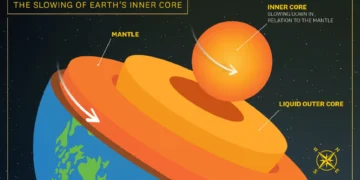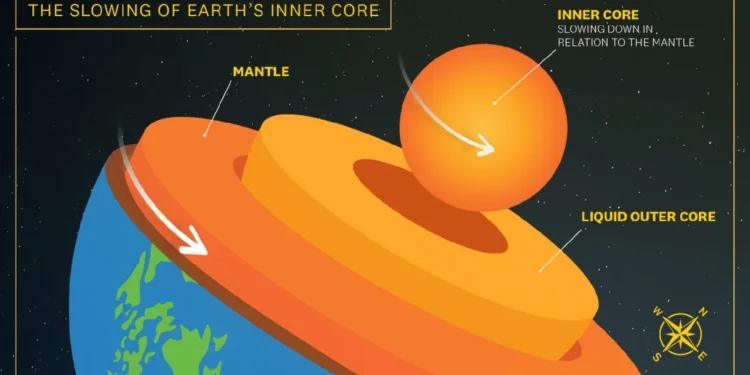For millions of years, Earth has been on a cosmic spin cycle, but recent research reveals something surprising—our planet’s rotation isn’t as smooth as we once believed. In fact, Earth’s rotation has been slowing down in a unique staircase pattern, marking moments of sudden deceleration followed by long periods of stability. The discovery published in the Proceedings of the National Academy of Sciences, flips our understanding of Earth’s rotational history on its head. So, why does this matter? How does this slow dance through time link to Earth’s past, and what could it mean for the future of our planet? Let’s dive in and uncover the secrets hidden in Earth’s cosmic rhythm.
The study, conducted by a team of geoscientists, reveals that Earth’s rotational deceleration hasn’t been a smooth process. Instead, it has followed a staircase pattern, with periods of slowdown followed by long periods of stability. This new understanding came from analyzing sediment samples dating back more than 650 million years, offering a geological timeline of Earth’s rotation.
This pattern suggests that Earth’s rotation has undergone phases of deceleration, which were later stabilized for millions of years. By examining eight geological datasets compiled over several decades, scientists found that Earth’s rotational history is recorded in the sediments and rock formations left behind through millennia. These sediments don’t just provide clues to our geographic history but also hold the key to Earth’s rotational past.
The discovery of this pattern challenges the long-held belief that Earth’s rotation has been slowing down at a constant rate due to tidal dissipation. Instead, the research shows that the deceleration occurred in distinct phases, providing a more nuanced view of how Earth’s rotation has evolved over time.
The Connection Between Rotational Changes and Major Environmental Events
One of the most intriguing findings of the study is the connection between Earth’s rotational changes and major environmental events. Researchers identified two notable periods of stability in Earth’s rotation that coincided with significant moments in Earth’s history. The first of these periods occurred during the Cambrian explosion, approximately 541 million years ago, when life on Earth underwent a dramatic increase in diversity. The second period aligns with the largest known mass extinction event, which wiped out approximately 90% of marine species and 70% of terrestrial species.
These stable periods suggest a possible link between the planet’s rotation and its environmental conditions. Could Earth’s rotational changes have played a role in shaping the conditions that led to these dramatic biological shifts? While it’s too early to draw definitive conclusions, the evidence presents a tantalizing possibility. The idea that changes in Earth’s rotation might influence global environmental conditions opens the door to new areas of research that could reshape our understanding of the planet’s past.
So, what exactly is causing Earth’s rotation to slow down? The primary factor is tidal dissipation, a process in which the gravitational forces between Earth, its oceans, and the moon cause energy to dissipate as heat. As the moon’s gravity pulls on Earth’s oceans, it creates tidal bulges, which in turn exert a backward torque on the planet’s rotation. This interaction gradually slows Earth’s spin.
The study confirmed that except for modern times, where human activities have disrupted Earth’s natural systems, the primary cause of Earth’s rotational deceleration has been tidal dissipation. Over the past 650 million years, this process has not only slowed Earth’s spin but also pushed the moon approximately 20,000 kilometers farther away from Earth. This distance shift has contributed to lengthening Earth’s days by about 2.2 hours over the studied period.
Implications of Earth’s Rotational Deceleration
One of the most noticeable effects is the lengthening of Earth’s days. Today, we experience 24-hour days, but millions of years ago, a day on Earth was shorter. As the planet continues to slow down, days will become incrementally longer—a change that, while imperceptible in our daily lives, has profound long-term consequences.
This deceleration also raises questions about how it might impact Earth’s future. Could the continued slowdown of Earth’s rotation influence the planet’s climate, ocean currents, or even tectonic activity? While these questions remain largely speculative, they underscore the importance of studying Earth’s rotational history to better anticipate future changes.
Furthermore, the study’s findings offer a glimpse into the delicate balance that governs our planet’s rotation. For billions of years, natural forces such as tidal dissipation have been driving Earth’s rotational evolution. However, in modern times, human activities—such as the construction of massive reservoirs, shifts in ocean currents due to climate change, and even glacial melting—have started to influence Earth’s rotation as well. Understanding the natural staircase pattern of Earth’s rotational deceleration provides a baseline for assessing how human actions are impacting this delicate balance.
Future Research: What’s Next for Earth’s Rotational Studies?
While this study has provided new insights into Earth’s rotational history, there are still many unanswered questions. The research team plans to continue investigating the potential links between changes in Earth’s rotation and significant environmental events. By expanding their study to include more recent geological records, they hope to better understand how fluctuations in Earth’s rotation have influenced major transitions in the planet’s climate and biodiversity.
Additionally, future research could explore the relationship between Earth’s rotational changes and the movement of tectonic plates, volcanic activity, and even magnetic field shifts. These factors may all play a role in the planet’s long-term evolution and could provide new clues about how Earth’s rotation influences global processes.
One key area of interest is how Earth’s rotational deceleration might impact the planet’s climate in the future. As the planet’s rotation continues to slow, even small changes in the length of days could affect weather patterns, ocean currents, and temperature distribution. Researchers are eager to explore these possibilities in greater depth, as understanding the relationship between Earth’s rotation and climate could offer valuable insights into how the planet might respond to ongoing environmental changes.
By studying the geological record, scientists are uncovering new insights into the forces that have shaped our planet over millions of years. These discoveries remind us that Earth is a dynamic system, constantly evolving and influenced by a complex interplay of forces both on the surface and in space.
As researchers continue to explore the connections between Earth’s rotational history and its environmental conditions, we may gain a deeper understanding of the planet’s past—and perhaps even better predict its future. The staircase pattern of Earth’s rotational deceleration is a key piece of this puzzle, offering new perspectives on how our planet has evolved and what lies ahead.
References:



















